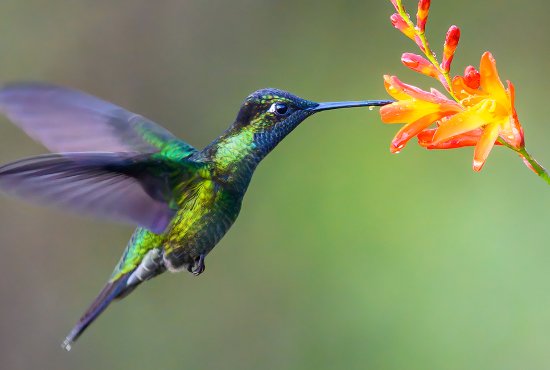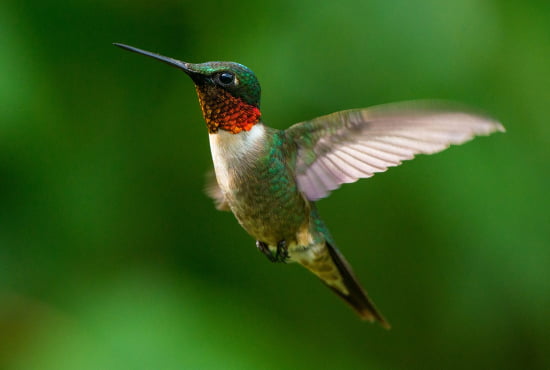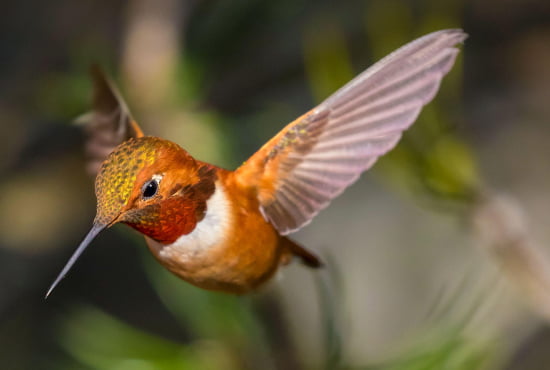What’s So Special About Humming birds?
Humming birds can be found in Central and South America, on the islands of the Caribbean, and as far north as the United States (mainly in California). There are over 330 species of hummingbirds, making it the world’s largest family of birds. Hummingbirds are remarkable creatures; they are capable of hovering, flying backward, and even flying upside down at speeds of up to 30 miles per hour! Their wings move so fast that they beat 50-200 times per second, depending on their species and energy output. They feed primarily on nectar from flowers, along with small insects.
Humming birds are a marvel of evolution. They can hover in place, fly backward, and even upside down, thanks to specially adapted wings that allow them to make rapid and precise movements. In addition to their ability to fly, hummingbirds are equipped with numerous other adaptations that help them to survive in difficult environments. Their wings move so fast they can create their wind tunnel—hummingbirds have been measured at speeds of up to 60 miles per hour (96 kilometres per hour) in this state—which is important for helping them remain stable as they’re nectar-drinking from deep flower tubes.

Size and Appearance
Hummingbirds have many unique physical characteristics. Most hummingbirds are small birds, but they can be as tiny as two centimetres (just over an inch) or as large as 15 centimetres (six inches). The smallest bird in America is a hummingbird, so it’s no surprise that these animals boast some of nature’s most well-developed physiques. Hummies are known for their long, narrow bills and tails; their bodies tend to be plump and compact with short necks. Their legs tend to be very thin, allowing them to easily perch on branches without crushing under their weight.
Shape and Colour
Hummingbirds come in many different shapes and colours. They have large heads, stocky bodies, and long tails that they frequently use to hover while feeding. Their bills are straight with a hooked tip to help them lap up nectar from flowers. They also have long, sharp claws used for clinging to branches and perching on thorns and wires. Their wings are very thin and very strong; many species can even fly backward! Female hummingbirds usually grow larger than males, though it varies based on their habitat type.

Diet and Behaviour
Humming birds have a voracious appetite and they eat multiple times a day. They don’t drink like other birds but their nectar-rich diet provides them with adequate hydration. Hummingbirds have to visit flowers several times a day to meet their energy demands. To do so, they flap their wings at an incredible rate of up to 80 flaps per second! This allows them to take advantage of every bit of available sunlight, which is especially important when food is scarce (such as during winter). But it also means that hummers can fly hundreds of miles each day from flower patch to flower patch.
Humming bird Families
Humming birds belong to more than 100 different species in 17 genera. Many hummingbirds are colourful, but some have a greenish tinge and many birds of this family have iridescent feathers. Some hummingbirds are even able to change colours based on their mood or temperature. The smallest species of hummingbird is an adult who weighs as little as 2 grams (0.07 oz). The largest is a giant hummingbird that weighs more than 15 grams (0.53 oz) – larger than a sparrow!

Incredible Facts
- Hummingbirds may have a bad reputation for being aggressive, but don’t let their tiny stature fool you.
- Hummers are fierce protectors of their territory and will do whatever it takes to defend it.
- They can even recognize intruders who don’t belong in their area and will chase them away using aggressive aerial manoeuvres.
- They can travel at speeds up to 30 miles per hour! To keep their energy up throughout long flights, hummingbirds eat twice as much as other birds their size.
- To keep from getting dizzy from all that head-spinning activity (you know hummingbirds flap their wings fast), these avian acrobats only need about two hours of sleep every night.
- During those rare instances when they get caught on land during storms or cold weather, hummers use torpor—essentially hibernation without freezing—to survive until spring thaw or summer temperatures return.
- The average lifespan of a hummingbird is two years; however, some species can live as long as ten years with appropriate care in captivity…

